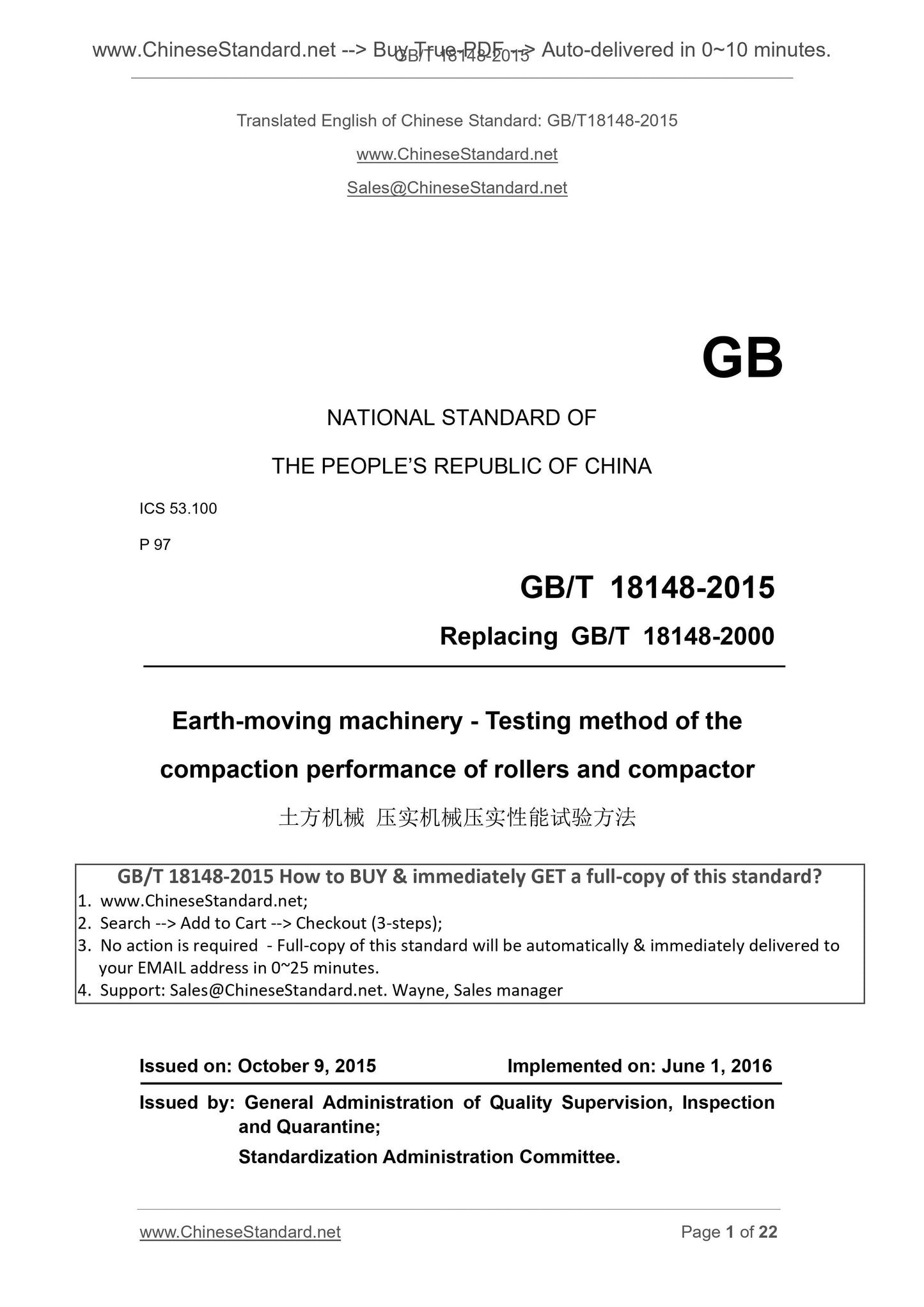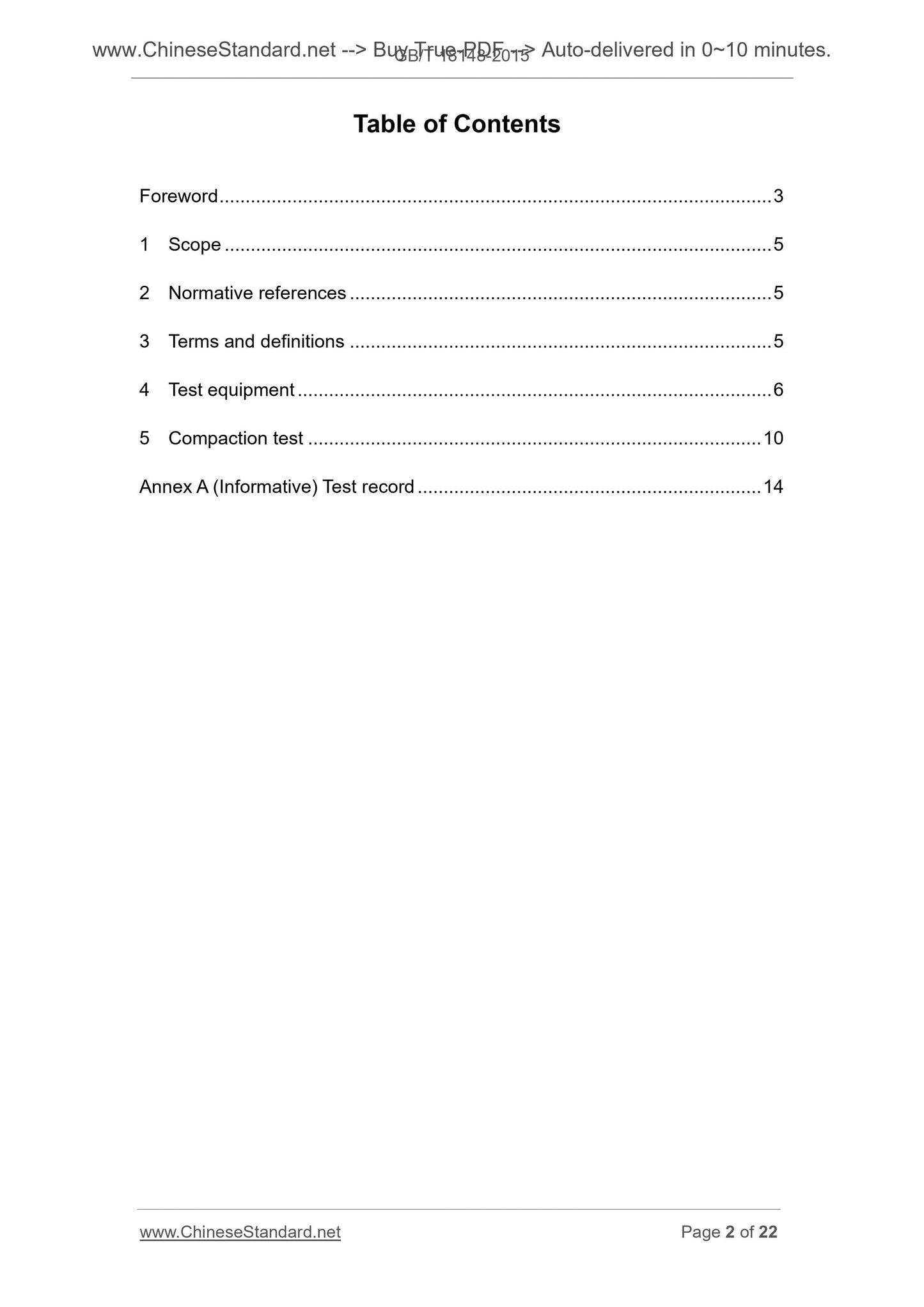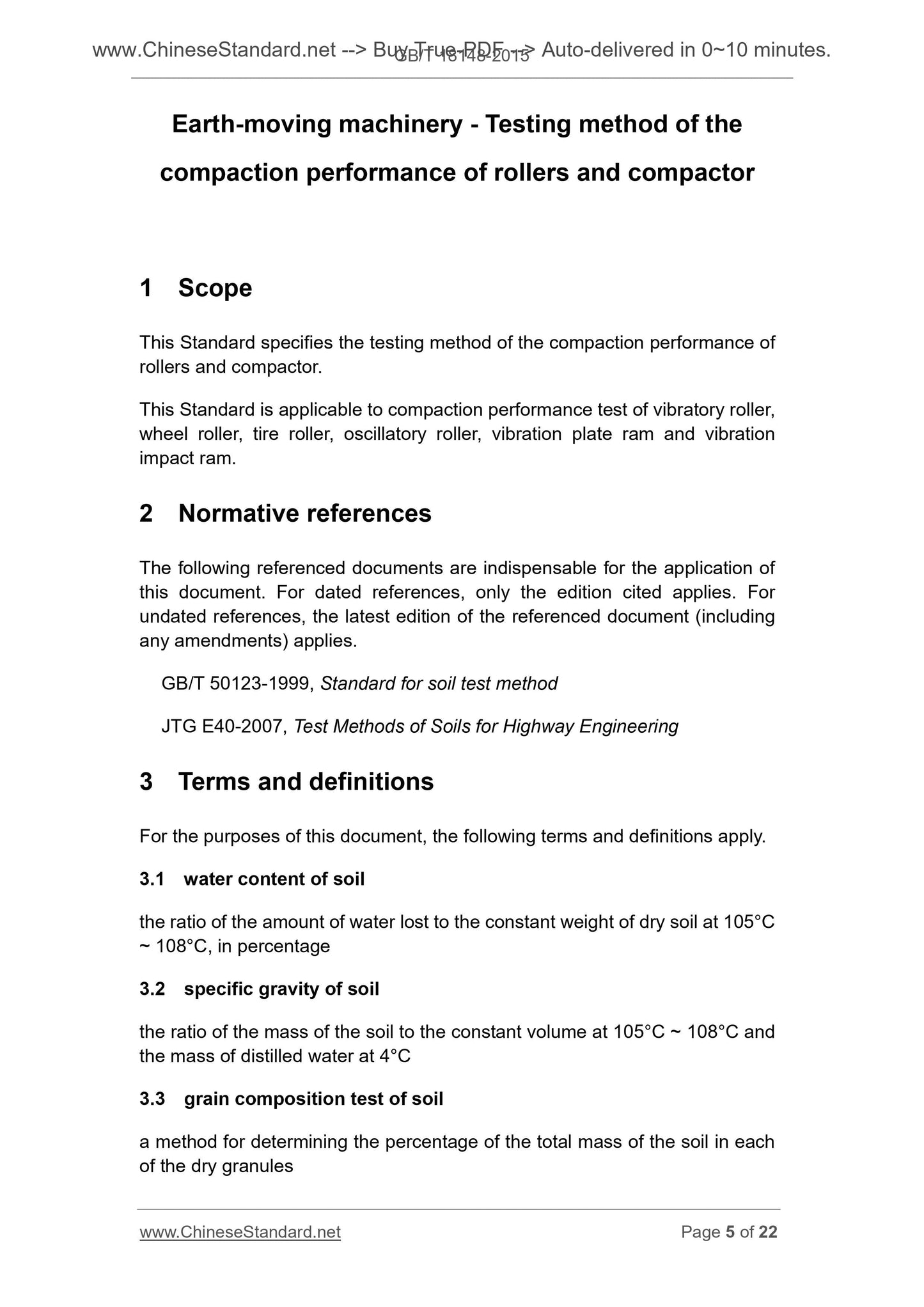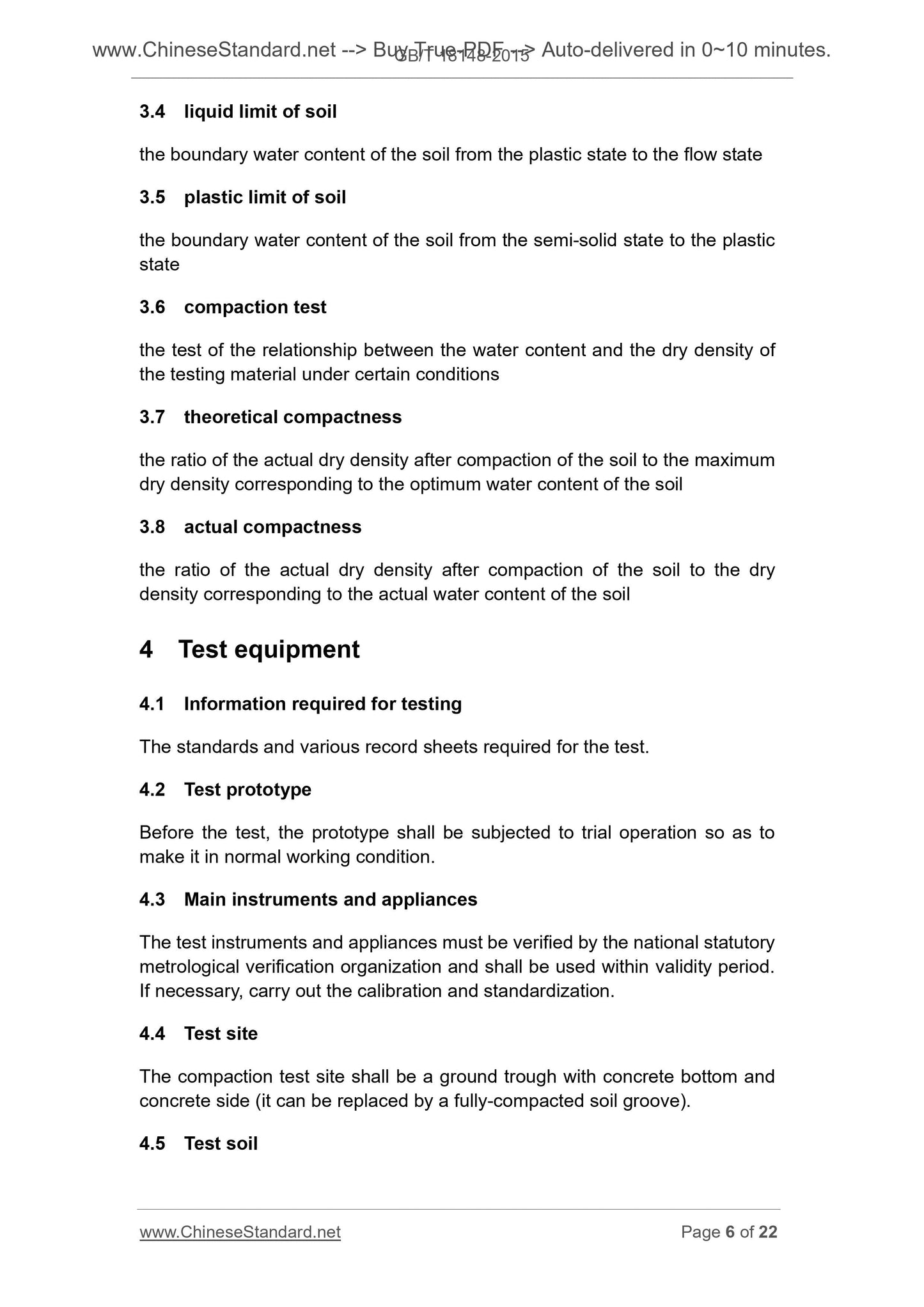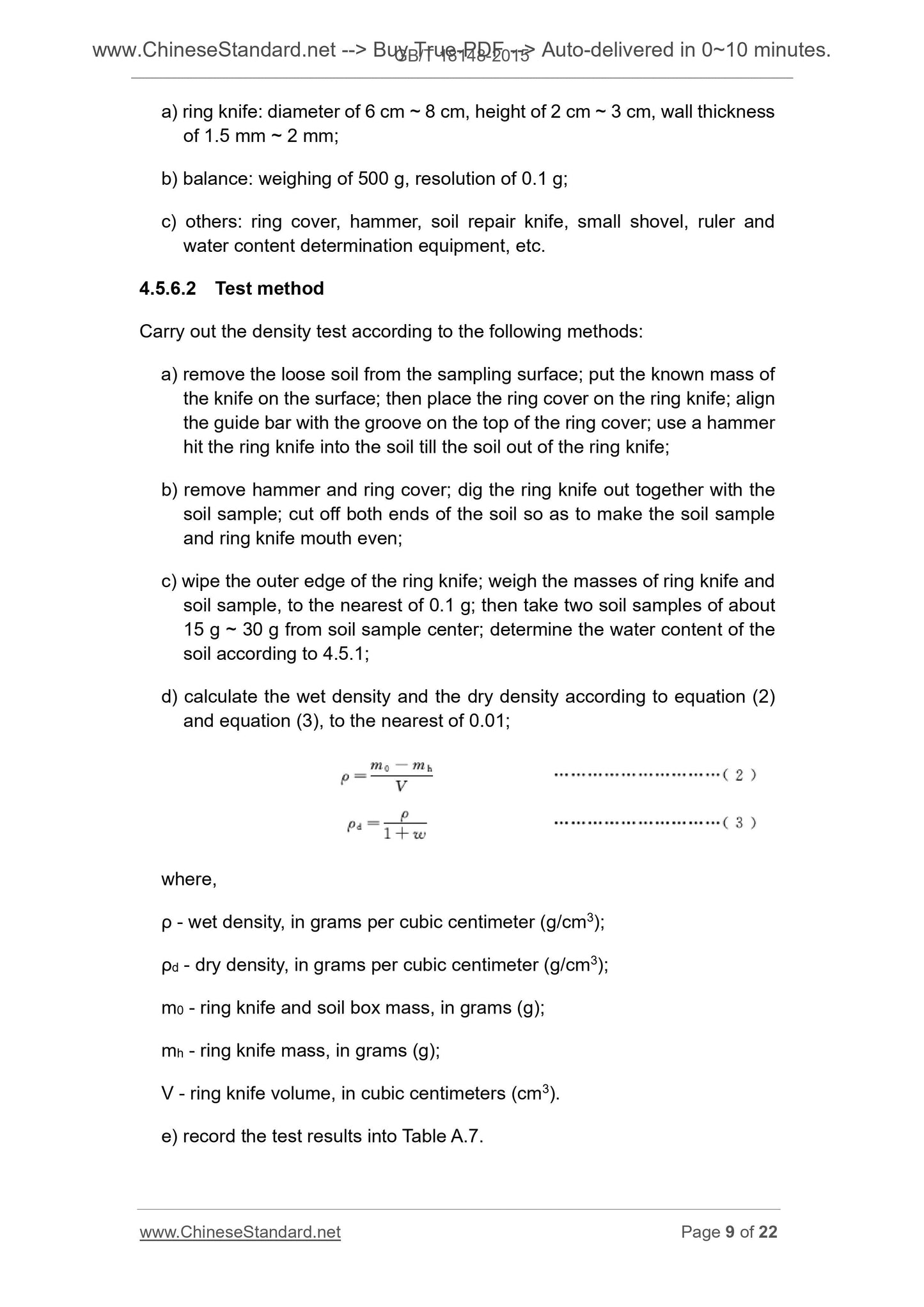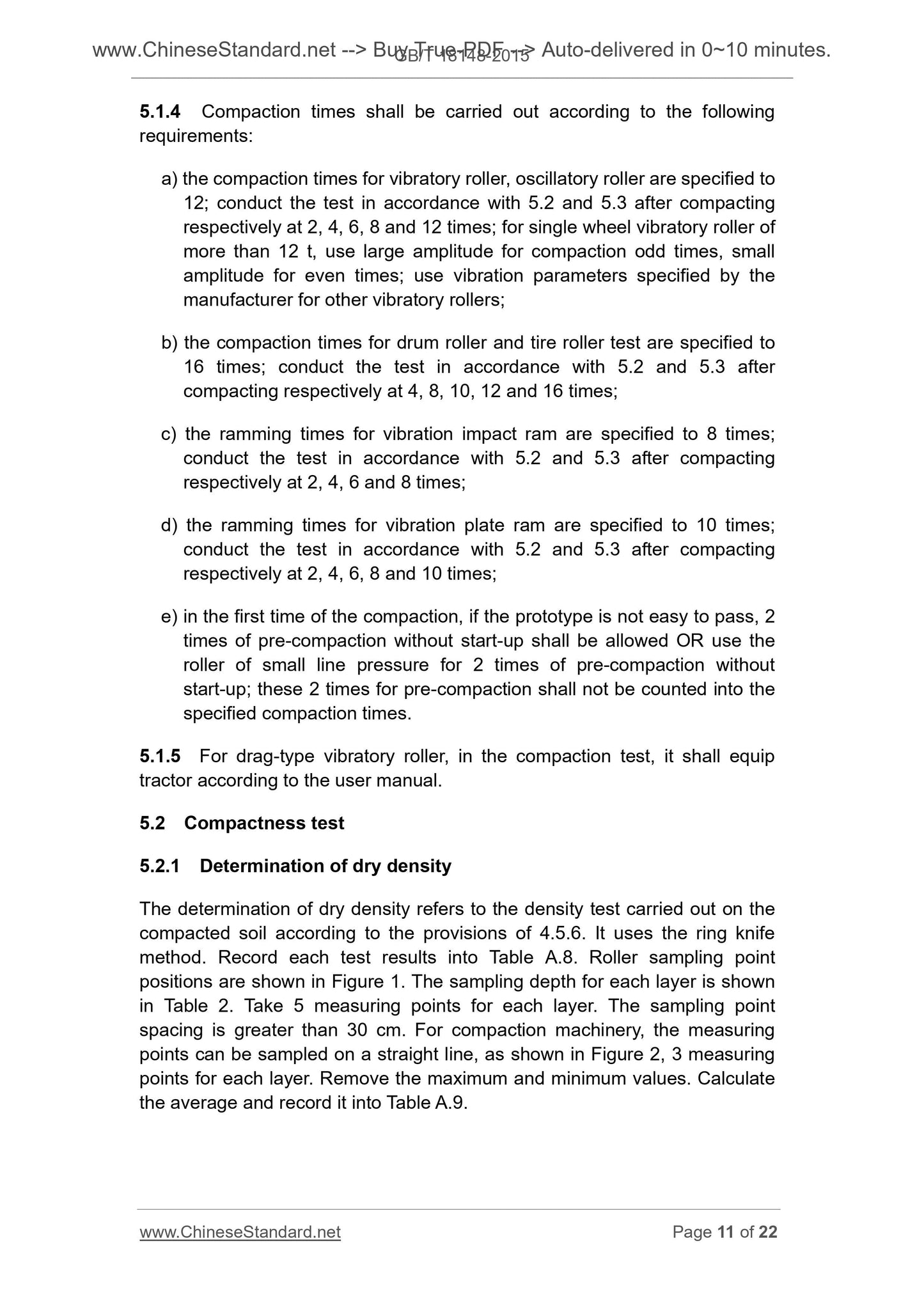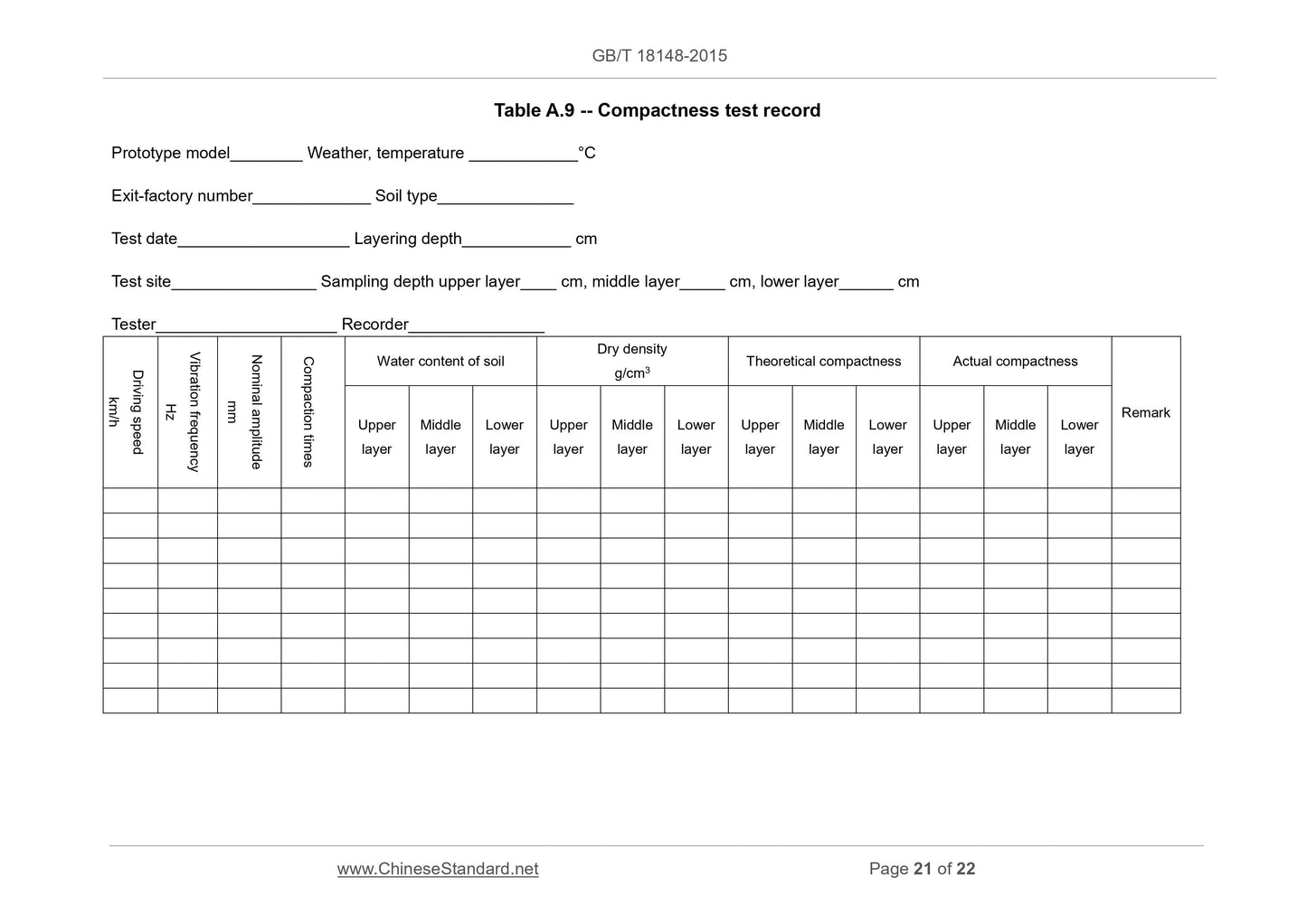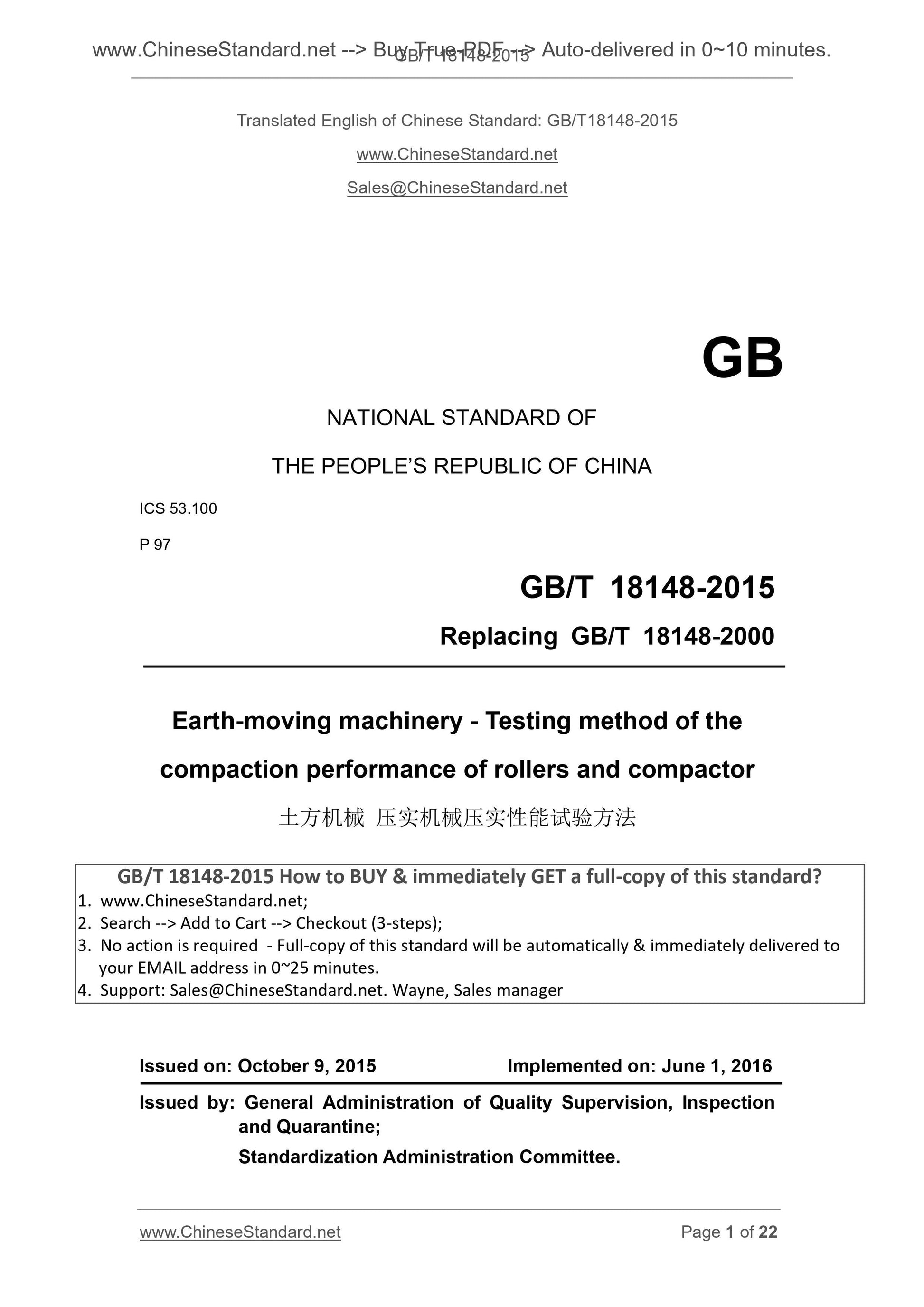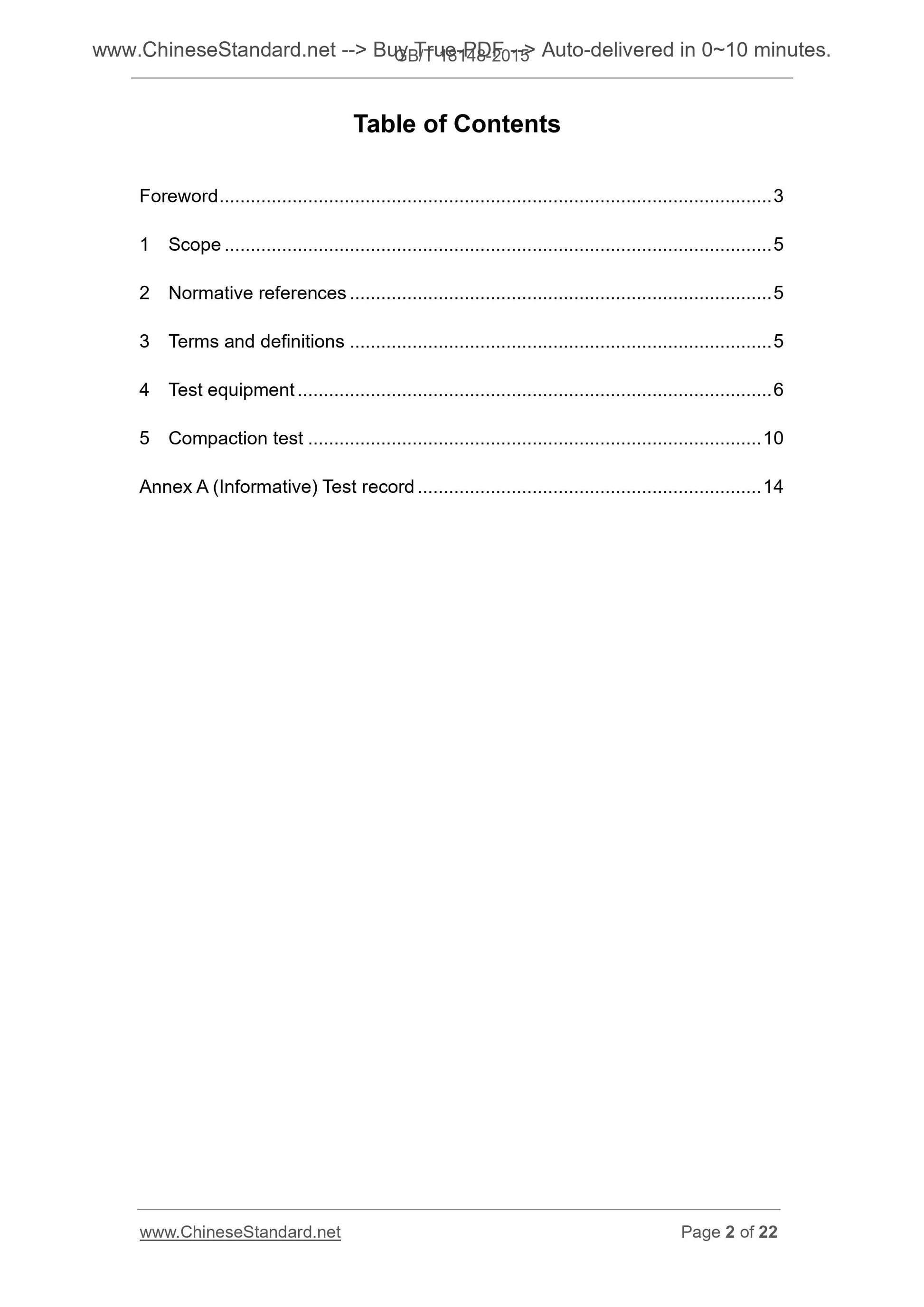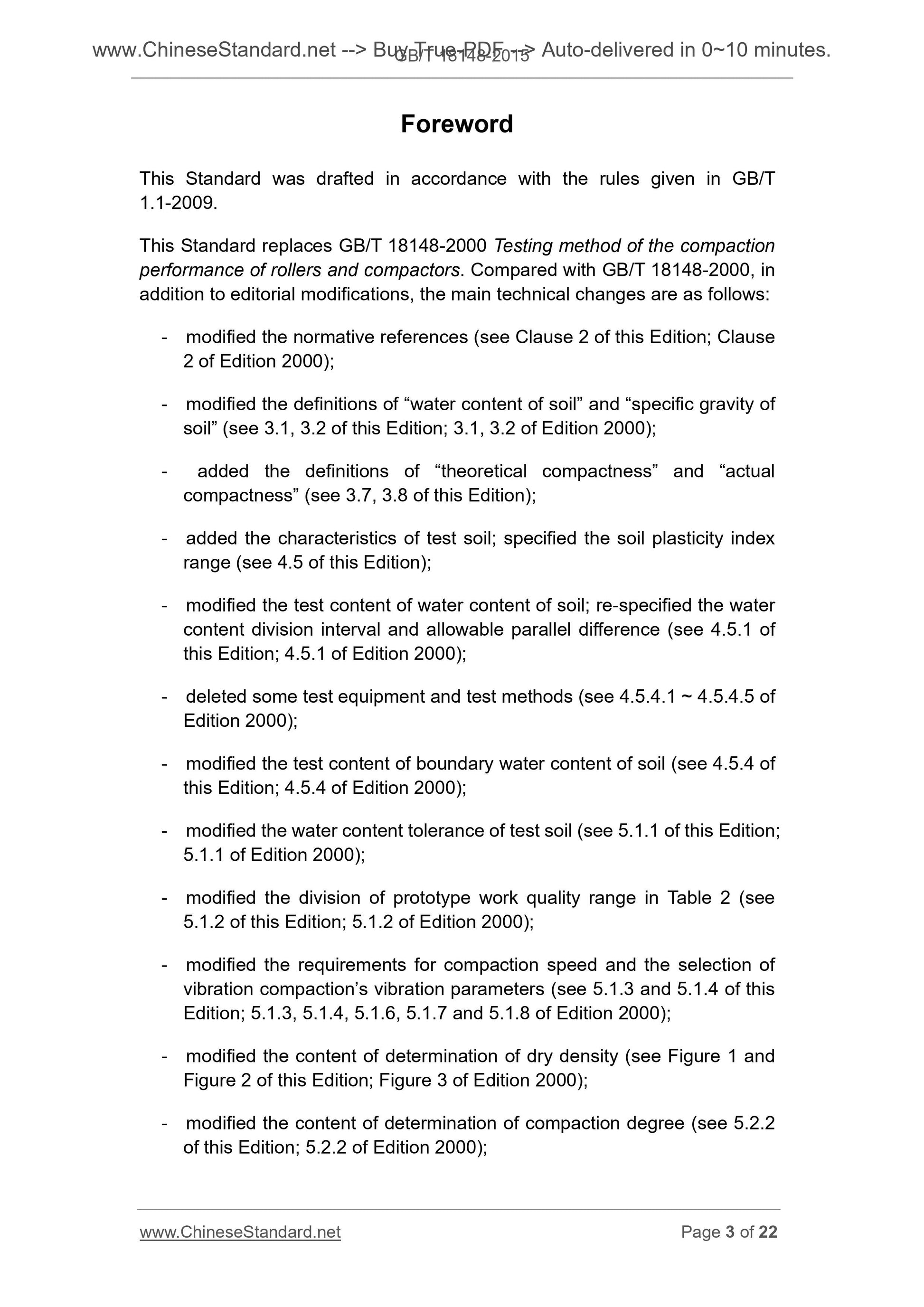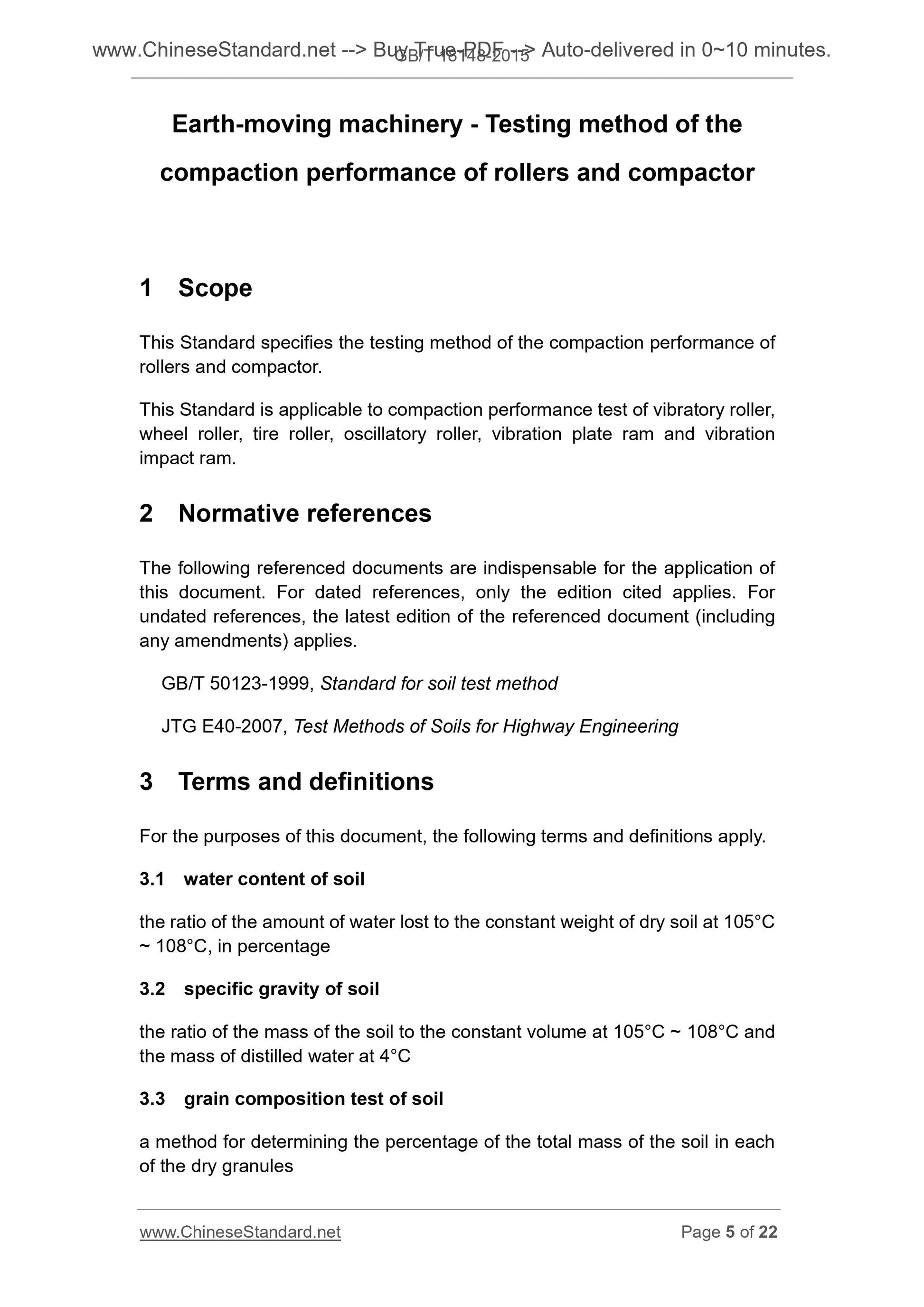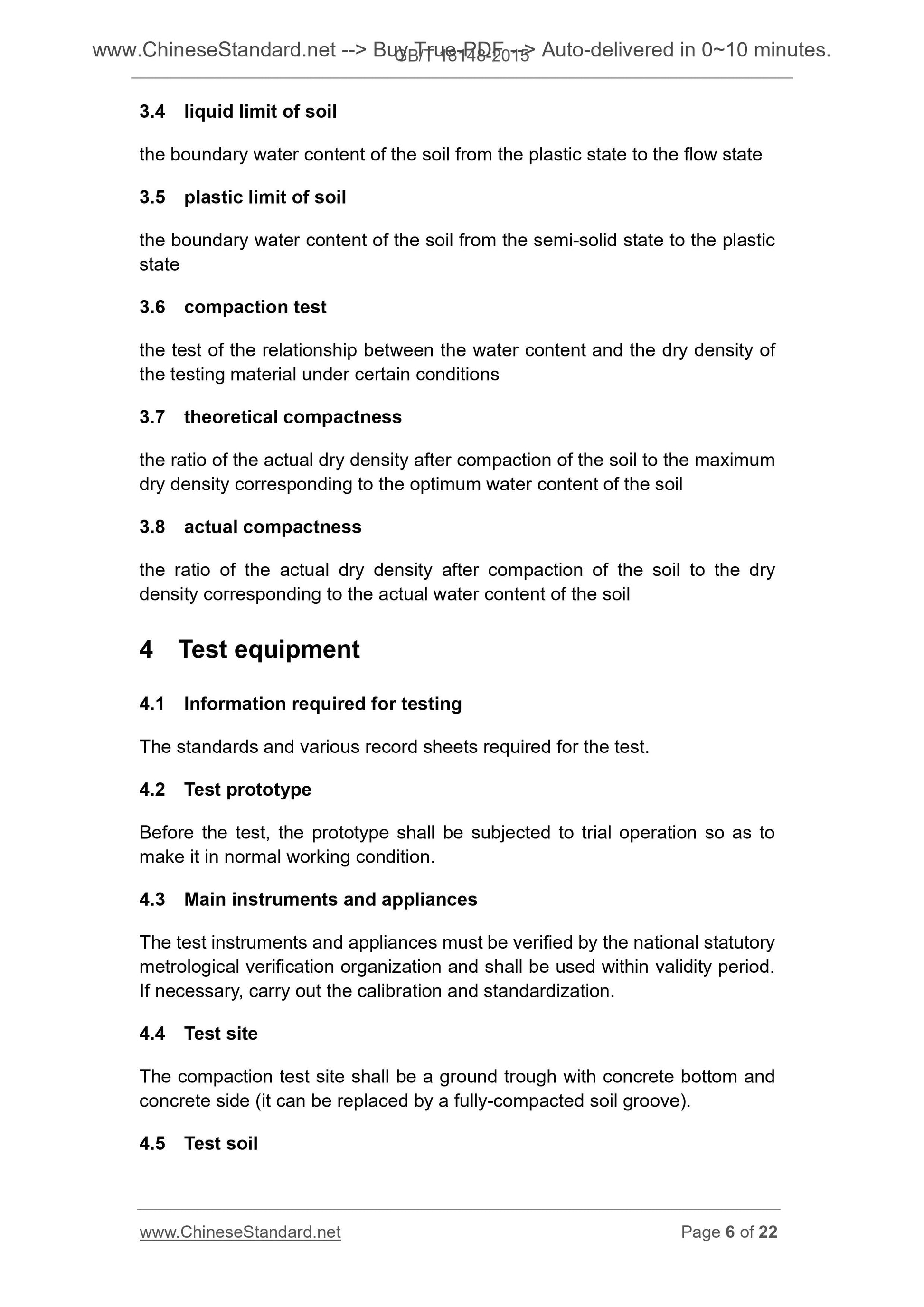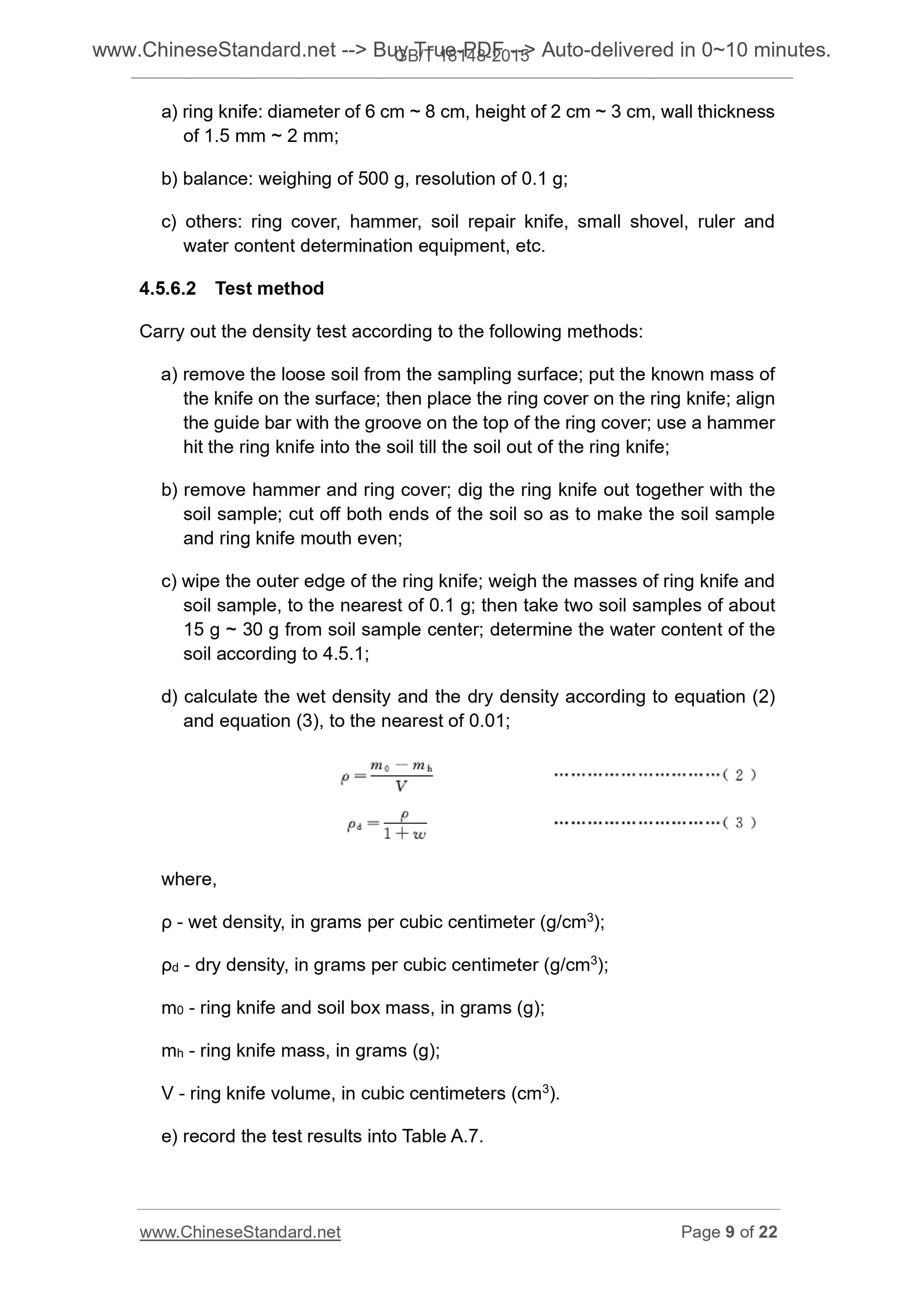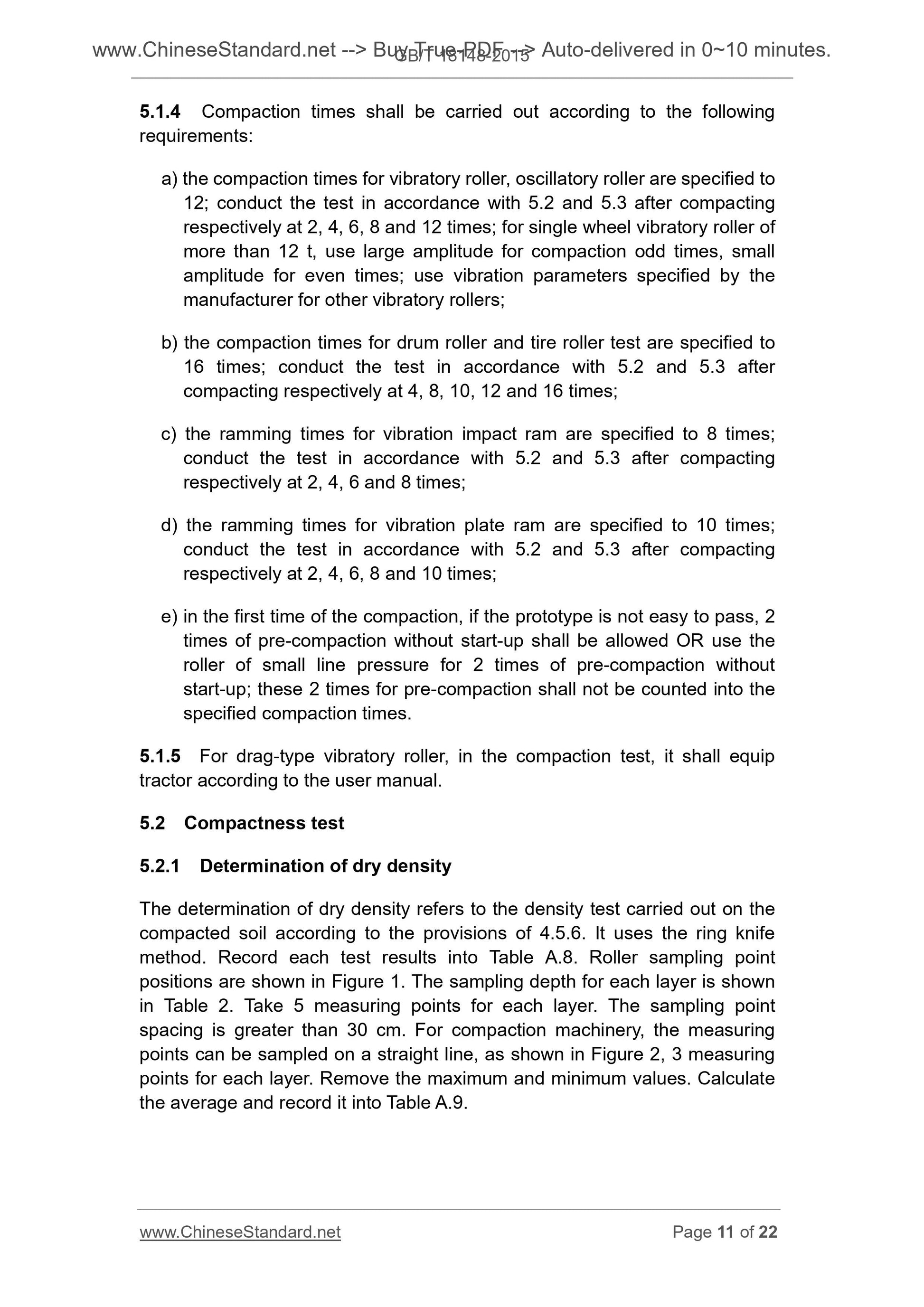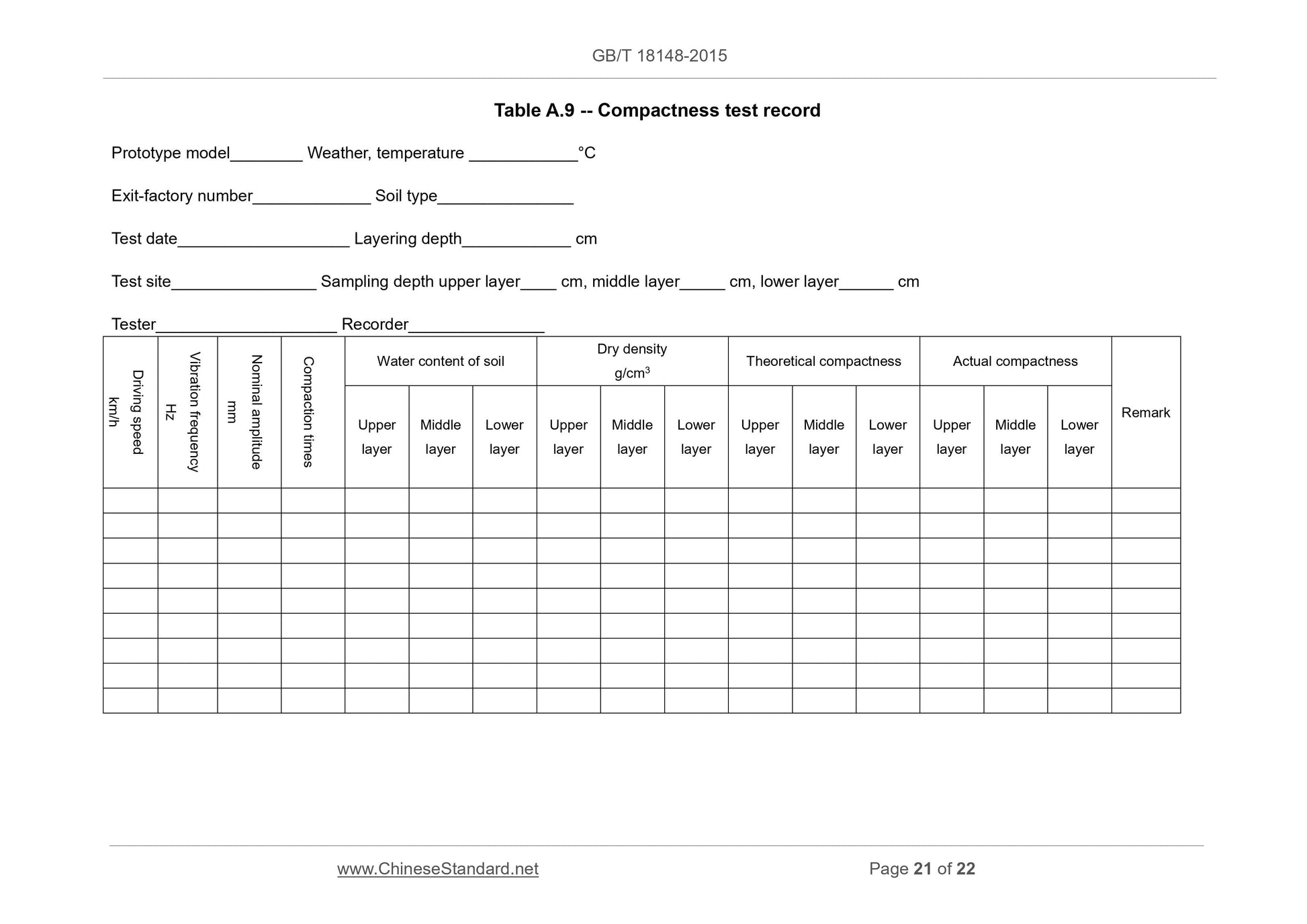1
/
of
8
PayPal, credit cards. Download editable-PDF & invoice in 1 second!
GB/T 18148-2015 English PDF (GBT18148-2015)
GB/T 18148-2015 English PDF (GBT18148-2015)
Regular price
$140.00 USD
Regular price
Sale price
$140.00 USD
Unit price
/
per
Shipping calculated at checkout.
Couldn't load pickup availability
Delivery: 3 seconds. Download true-PDF + Invoice.
Get QUOTATION in 1-minute: Click GB/T 18148-2015
Historical versions: GB/T 18148-2015
Preview True-PDF (Reload/Scroll if blank)
GB/T 18148-2015: Earth-moving machinery -- Testing method of the compaction performance of rollers and compactors
GB/T 18148-2015
GB
NATIONAL STANDARD OF
THE PEOPLE’S REPUBLIC OF CHINA
ICS 53.100
P 97
Replacing GB/T 18148-2000
Earth-moving machinery - Testing method of the
compaction performance of rollers and compactor
ISSUED ON. OCTOBER 9, 2015
IMPLEMENTED ON. JUNE 1, 2016
Issued by. General Administration of Quality Supervision, Inspection
and Quarantine;
Standardization Administration Committee.
Table of Contents
Foreword ... 3
1 Scope ... 5
2 Normative references ... 5
3 Terms and definitions ... 5
4 Test equipment ... 6
5 Compaction test ... 10
Annex A (Informative) Test record ... 14
Foreword
This Standard was drafted in accordance with the rules given in GB/T
1.1-2009.
This Standard replaces GB/T 18148-2000 Testing method of the compaction
performance of rollers and compactors. Compared with GB/T 18148-2000, in
addition to editorial modifications, the main technical changes are as follows.
- modified the normative references (see Clause 2 of this Edition; Clause
2 of Edition 2000);
- modified the definitions of “water content of soil” and “specific gravity of
soil” (see 3.1, 3.2 of this Edition; 3.1, 3.2 of Edition 2000);
- added the definitions of “theoretical compactness” and “actual
compactness” (see 3.7, 3.8 of this Edition);
- added the characteristics of test soil; specified the soil plasticity index
range (see 4.5 of this Edition);
- modified the test content of water content of soil; re-specified the water
content division interval and allowable parallel difference (see 4.5.1 of
this Edition; 4.5.1 of Edition 2000);
- deleted some test equipment and test methods (see 4.5.4.1 ~ 4.5.4.5 of
Edition 2000);
- modified the test content of boundary water content of soil (see 4.5.4 of
this Edition; 4.5.4 of Edition 2000);
- modified the water content tolerance of test soil (see 5.1.1 of this Edition;
5.1.1 of Edition 2000);
- modified the division of prototype work quality range in Table 2 (see
5.1.2 of this Edition; 5.1.2 of Edition 2000);
- modified the requirements for compaction speed and the selection of
vibration compaction’s vibration parameters (see 5.1.3 and 5.1.4 of this
Edition; 5.1.3, 5.1.4, 5.1.6, 5.1.7 and 5.1.8 of Edition 2000);
- modified the content of determination of dry density (see Figure 1 and
Figure 2 of this Edition; Figure 3 of Edition 2000);
- modified the content of determination of compaction degree (see 5.2.2
of this Edition; 5.2.2 of Edition 2000);
Earth-moving machinery - Testing method of the
compaction performance of rollers and compactor
1 Scope
This Standard specifies the testing method of the compaction performance of
rollers and compactor.
This Standard is applicable to compaction performance test of vibratory roller,
wheel roller, tire roller, oscillatory roller, vibration plate ram and vibration
impact ram.
2 Normative references
The following referenced documents are indispensable for the application of
this document. For dated references, only the edition cited applies. For
undated references, the latest edition of the referenced document (including
any amendments) applies.
GB/T 50123-1999, Standard for soil test method
JTG E40-2007, Test Methods of Soils for Highway Engineering
3 Terms and definitions
For the purposes of this document, the following terms and definitions apply.
3.1 water content of soil
the ratio of the amount of water lost to the constant weight of dry soil at 105°C
~ 108°C, in percentage
3.2 specific gravity of soil
the ratio of the mass of the soil to the constant volume at 105°C ~ 108°C and
the mass of distilled water at 4°C
3.3 grain composition test of soil
a method for determining the percentage of the total mass of the soil in each
of the dry granules
3.4 liquid limit of soil
the boundary water content of the soil from the plastic state to the flow state
3.5 plastic limit of soil
the boundary water content of the soil from the semi-solid state to the plastic
state
3.6 compaction test
the test of the relationship between the water content and the dry density of
the testing material under certain conditions
3.7 theoretical compactness
the ratio of the actual dry density after compaction of the soil to the maximum
dry density corresponding to the optimum water content of the soil
3.8 actual compactness
the ratio of the actual dry density after compaction of the soil to the dry
density corresponding to the actual water content of the soil
4 Test equipment
4.1 Information required for testing
The standards and various record sheets required for the test.
4.2 Test prototype
Before the test, the prototype shall be subjected to trial operation so as to
make it in normal working condition.
4.3 Main instruments and appliances
The test instruments and appliances must be verified by the national statutory
metrological verification organization and shall be used within validity period.
If necessary, carry out the calibration and standardization.
4.4 Test site
The compaction test site shall be a ground trough with concrete bottom and
concrete side (it can be replaced by a fully-compacted soil groove).
4.5 Test soil
a) ring knife. diameter of 6 cm ~ 8 cm, height of 2 cm ~ 3 cm, wall thickness
of 1.5 mm ~ 2 mm;
b) balance. weighing of 500 g, resolution of 0.1 g;
c) others. ring cover, hammer, soil repair knife, small shovel, ruler and
water content determination equipment, etc.
4.5.6.2 Test method
Carry out the density test according to the following methods.
a) remove the loose soil from the sampling surface; put the known mass of
the knife on the surface; then place the ring cover on the ring knife; align
the guide bar with the groove on the top of the ring cover; use a hammer
hit the ring knife into the soil till the soil out of the ring knife;
b) remove hammer and ring cover; dig the ring knife out together with the
soil sample; cut off both ends of the soil so as to make the soil sample
and ring knife mouth even;
c) wipe the outer edge of the ring knife; weigh the masses of ring knife and
soil sample, to the nearest of 0.1 g; then take two soil samples of about
15 g ~ 30 g from soil sample center; determine the water content of the
soil according to 4.5.1;
d) calculate the wet density and the dry density according to equation (2)
and equation (3), to the nearest of 0.01;
where,
ρ - wet density, in grams per cubic centimeter (g/cm3);
ρd - dry density, in grams per cubic centimeter (g/cm3);
m0 - ring knife and soil box mass, in grams (g);
mh - ring knife mass, in grams (g);
V - ring knife volume, in cubic centimeters (cm3).
e) record the test results into Table A.7.
5.1.4 Compaction times shall be carried out according to the following
requirements.
a) the compaction times for vibratory roller, oscillatory roller are specified to
12; conduct the test in accordance with 5.2 and 5.3 after compacting
respectively at 2, 4, 6, 8 and 12 times; for single wheel vibratory roller of
more than 12 t, use large amplitude for compaction odd times, small
amplitude for even times; use vibration parameters specified by the
manufacturer for other vibratory rollers;
b) the compaction times for drum roller and tire roller test are specified to
16 times; conduct the test in accordance with 5.2 and 5.3 after
compacting respectively at 4, 8, 10, 12 and 16 times;
c) the ramming times for vibration i...
Get QUOTATION in 1-minute: Click GB/T 18148-2015
Historical versions: GB/T 18148-2015
Preview True-PDF (Reload/Scroll if blank)
GB/T 18148-2015: Earth-moving machinery -- Testing method of the compaction performance of rollers and compactors
GB/T 18148-2015
GB
NATIONAL STANDARD OF
THE PEOPLE’S REPUBLIC OF CHINA
ICS 53.100
P 97
Replacing GB/T 18148-2000
Earth-moving machinery - Testing method of the
compaction performance of rollers and compactor
ISSUED ON. OCTOBER 9, 2015
IMPLEMENTED ON. JUNE 1, 2016
Issued by. General Administration of Quality Supervision, Inspection
and Quarantine;
Standardization Administration Committee.
Table of Contents
Foreword ... 3
1 Scope ... 5
2 Normative references ... 5
3 Terms and definitions ... 5
4 Test equipment ... 6
5 Compaction test ... 10
Annex A (Informative) Test record ... 14
Foreword
This Standard was drafted in accordance with the rules given in GB/T
1.1-2009.
This Standard replaces GB/T 18148-2000 Testing method of the compaction
performance of rollers and compactors. Compared with GB/T 18148-2000, in
addition to editorial modifications, the main technical changes are as follows.
- modified the normative references (see Clause 2 of this Edition; Clause
2 of Edition 2000);
- modified the definitions of “water content of soil” and “specific gravity of
soil” (see 3.1, 3.2 of this Edition; 3.1, 3.2 of Edition 2000);
- added the definitions of “theoretical compactness” and “actual
compactness” (see 3.7, 3.8 of this Edition);
- added the characteristics of test soil; specified the soil plasticity index
range (see 4.5 of this Edition);
- modified the test content of water content of soil; re-specified the water
content division interval and allowable parallel difference (see 4.5.1 of
this Edition; 4.5.1 of Edition 2000);
- deleted some test equipment and test methods (see 4.5.4.1 ~ 4.5.4.5 of
Edition 2000);
- modified the test content of boundary water content of soil (see 4.5.4 of
this Edition; 4.5.4 of Edition 2000);
- modified the water content tolerance of test soil (see 5.1.1 of this Edition;
5.1.1 of Edition 2000);
- modified the division of prototype work quality range in Table 2 (see
5.1.2 of this Edition; 5.1.2 of Edition 2000);
- modified the requirements for compaction speed and the selection of
vibration compaction’s vibration parameters (see 5.1.3 and 5.1.4 of this
Edition; 5.1.3, 5.1.4, 5.1.6, 5.1.7 and 5.1.8 of Edition 2000);
- modified the content of determination of dry density (see Figure 1 and
Figure 2 of this Edition; Figure 3 of Edition 2000);
- modified the content of determination of compaction degree (see 5.2.2
of this Edition; 5.2.2 of Edition 2000);
Earth-moving machinery - Testing method of the
compaction performance of rollers and compactor
1 Scope
This Standard specifies the testing method of the compaction performance of
rollers and compactor.
This Standard is applicable to compaction performance test of vibratory roller,
wheel roller, tire roller, oscillatory roller, vibration plate ram and vibration
impact ram.
2 Normative references
The following referenced documents are indispensable for the application of
this document. For dated references, only the edition cited applies. For
undated references, the latest edition of the referenced document (including
any amendments) applies.
GB/T 50123-1999, Standard for soil test method
JTG E40-2007, Test Methods of Soils for Highway Engineering
3 Terms and definitions
For the purposes of this document, the following terms and definitions apply.
3.1 water content of soil
the ratio of the amount of water lost to the constant weight of dry soil at 105°C
~ 108°C, in percentage
3.2 specific gravity of soil
the ratio of the mass of the soil to the constant volume at 105°C ~ 108°C and
the mass of distilled water at 4°C
3.3 grain composition test of soil
a method for determining the percentage of the total mass of the soil in each
of the dry granules
3.4 liquid limit of soil
the boundary water content of the soil from the plastic state to the flow state
3.5 plastic limit of soil
the boundary water content of the soil from the semi-solid state to the plastic
state
3.6 compaction test
the test of the relationship between the water content and the dry density of
the testing material under certain conditions
3.7 theoretical compactness
the ratio of the actual dry density after compaction of the soil to the maximum
dry density corresponding to the optimum water content of the soil
3.8 actual compactness
the ratio of the actual dry density after compaction of the soil to the dry
density corresponding to the actual water content of the soil
4 Test equipment
4.1 Information required for testing
The standards and various record sheets required for the test.
4.2 Test prototype
Before the test, the prototype shall be subjected to trial operation so as to
make it in normal working condition.
4.3 Main instruments and appliances
The test instruments and appliances must be verified by the national statutory
metrological verification organization and shall be used within validity period.
If necessary, carry out the calibration and standardization.
4.4 Test site
The compaction test site shall be a ground trough with concrete bottom and
concrete side (it can be replaced by a fully-compacted soil groove).
4.5 Test soil
a) ring knife. diameter of 6 cm ~ 8 cm, height of 2 cm ~ 3 cm, wall thickness
of 1.5 mm ~ 2 mm;
b) balance. weighing of 500 g, resolution of 0.1 g;
c) others. ring cover, hammer, soil repair knife, small shovel, ruler and
water content determination equipment, etc.
4.5.6.2 Test method
Carry out the density test according to the following methods.
a) remove the loose soil from the sampling surface; put the known mass of
the knife on the surface; then place the ring cover on the ring knife; align
the guide bar with the groove on the top of the ring cover; use a hammer
hit the ring knife into the soil till the soil out of the ring knife;
b) remove hammer and ring cover; dig the ring knife out together with the
soil sample; cut off both ends of the soil so as to make the soil sample
and ring knife mouth even;
c) wipe the outer edge of the ring knife; weigh the masses of ring knife and
soil sample, to the nearest of 0.1 g; then take two soil samples of about
15 g ~ 30 g from soil sample center; determine the water content of the
soil according to 4.5.1;
d) calculate the wet density and the dry density according to equation (2)
and equation (3), to the nearest of 0.01;
where,
ρ - wet density, in grams per cubic centimeter (g/cm3);
ρd - dry density, in grams per cubic centimeter (g/cm3);
m0 - ring knife and soil box mass, in grams (g);
mh - ring knife mass, in grams (g);
V - ring knife volume, in cubic centimeters (cm3).
e) record the test results into Table A.7.
5.1.4 Compaction times shall be carried out according to the following
requirements.
a) the compaction times for vibratory roller, oscillatory roller are specified to
12; conduct the test in accordance with 5.2 and 5.3 after compacting
respectively at 2, 4, 6, 8 and 12 times; for single wheel vibratory roller of
more than 12 t, use large amplitude for compaction odd times, small
amplitude for even times; use vibration parameters specified by the
manufacturer for other vibratory rollers;
b) the compaction times for drum roller and tire roller test are specified to
16 times; conduct the test in accordance with 5.2 and 5.3 after
compacting respectively at 4, 8, 10, 12 and 16 times;
c) the ramming times for vibration i...
Share
